I recently had a conversation with our church administrator about power. He was thinking of totally isolating the office from the grid and operating with diesel generators. I told him that would be a big mistake as diesel is an expensive power source. I explained to him that cost curves exist to substantiate this.
To assess the cost of power, one must first understand the concept of levelized cost. Levelized cost, comprehends various aspects of power generation, such as capacity factor (i.e. no of hours operation), investment, environmental costs, etc. Typically, fuel based sources would have costs increasing directly proportional to hours utilization. These values are plotted in busbar cost screening curves showing you what sources would be best to operate for certain durations.
The figure below contains screening curves for generation options in Cambodia. It shows that for less than 4000h/year operation, Open cycle gas turbines (OCGT) are cheaper. Beyond that, Combined Cycle turbines are preferred. While hydro appears high, the flatness of its curve makes it an attractive option. With cost optimizations and policy adjustments, hydro could be the least cost option in this case.
 Cambodia: Screening Curves (Source: World Bank)
Cambodia: Screening Curves (Source: World Bank)
In the Philippines, geothermal and hydro compete with diesel and coal. The intercept points are much lower than that of the above case. By using screening curves, in couple 8760h demand plots, you can identify the right power source for each market segment. Peak loads could be best supported by diesel. Midrange needs could be met by gas turbines (natural gas). Baseload requirements, by geothermal, hydro or coal.
An interesting case for not selecting power sources correctly would be that of Iloilo City, Philippines. Under the franchise of the Panay Electric Company, the power rates are one of the highest in the world at PHP14/kWh. All because of a decision to run solely on diesel.
Whether you are a distribution utility or a private company contracting power, it would be good practice to use screening curves to guide you in purchasing power.






















